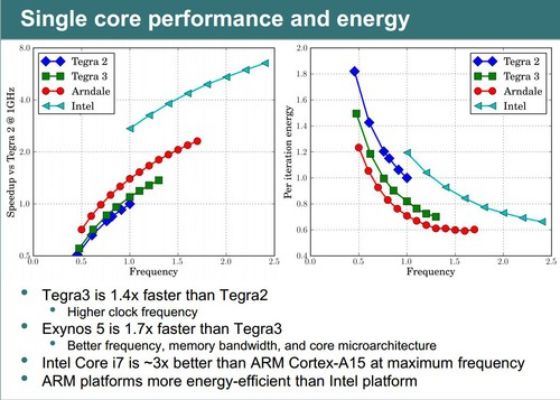ARM as the basis for new supercomputers

The Spanish BRC Center (Barcelona Supercomputing Center) conducted a study, according to which in the future ARM chips, similar to those used in modern smartphones, will be able to replace more expensive and energy-intensive x86 architecture processors in supercomputers and servers. The results of the study were presented in the article “Are mobile processors ready for HPC?” Presented to the public at EDAworkshop13, held this month in Dresden.
In their work, researchers predict a repetition of the history of the end of the 20th century, when RISC chips supplanted more expensive vector processors used in the overwhelming number of supercomputers. RISC, in turn, were replaced with x86 processors like Intel Xeon or AMD Opteron, which still serve as the basis for more than 400 of the world's 500 most powerful supercomputers. BRC experts say that when forecasting the development of technologies used in high-performance systems, attention should be paid not only to power, but also to the price of the chip, as well as its size. "Mobile processors are not faster ... but they are much cheaper," the researchers write.

Comparative dynamics of x86 and ARM chips
The cheapness of ARM chips is largely due to their prevalence: they are used in almost every modern smartphone or tablet. The only exception is the Atom, developed by Intel on the x86 architecture. The interest of large companies in the use of mobile processors in servers is also caused by an attempt to increase their energy efficiency. It is considered that powerful Xeon and Opteron are perfect for complex calculations related to large databases or ERP systems, however, to handle a large number of small tasks, such as processing search results or "likes" on social networks, according to researchers, more Economical ARM fit.
')
One of the tasks of the Barcelona Supercomputing Center is to create a prototype computing system, which has a large indicator of the efficiency of calculations in relation to the energy consumed (performance-per-watt). Already, with the financial support of the Spanish government and the EU, the company is building servers based on the quad-core NvidiaTegra 3 and the dual-core Samsung Exynos 5250.

Benchmarks of multicore ARM chips from Nvidia and Samsung
In addition to Spanish researchers, HP, for example, was developing the idea of using mobile processors for high-performance computing, developing the second version of its mobile server system Moonshot using ARM chips from Calxeda and Texas Instruments. Dell has also developed a prototype server on ARM chips and is considering using cost-effective chips in supercomputers.
Source: https://habr.com/ru/post/181011/
All Articles